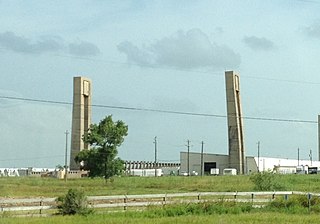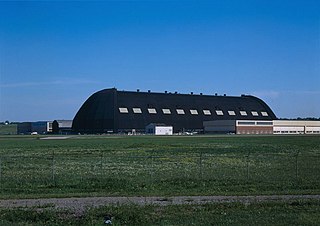Related Research Articles

Moffett Federal Airfield, also known as Moffett Field, is a joint civil-military airport located in an unincorporated part of Santa Clara County, California, United States, between northern Mountain View and northern Sunnyvale. On November 10, 2014, NASA announced that it would be leasing 1,000 acres (400 ha) of the airfield property to Google for 60 years.

Elizabeth City is a city in Pasquotank and Camden counties, North Carolina, United States. As of the 2020 census, it had a population of 18,629. Elizabeth City is the county seat and most populous city of Pasquotank County. It is the cultural, economic and educational hub of the sixteen-county Historic Albemarle region of northeastern North Carolina.

A hangar is a building or structure designed to hold aircraft or spacecraft. Hangars are built of metal, wood, or concrete. The word hangar comes from Middle French hanghart, of Germanic origin, from Frankish *haimgard, from *haim and gard ("yard"). The term, gard, comes from the Old Norse garðr.

Lakehurst Maxfield Field, formerly known as Naval Air Engineering Station Lakehurst, is the naval component of Joint Base McGuire–Dix–Lakehurst, a United States Air Force-managed joint base headquartered approximately 25 mi (40 km) east-southeast of Trenton in Manchester Township and Jackson Township in Ocean County, New Jersey, United States. It is primarily the home to Naval Air Warfare Center Aircraft Division Lakehurst, although the airfield supports several other flying and non-flying units as well. Its name is an amalgamation of its location and the last name of Commander Louis H. Maxfield, who lost his life when the R-38/USN ZR-2 airship crashed during flight on 24 August 1921 near Hull, England.

Coast Guard Air Station Elizabeth City is a United States Coast Guard Air Station co-located at Elizabeth City Regional Airport in Elizabeth City, North Carolina, along the Pasquotank River near the opening of the Albemarle Sound. The base has a garrison of approximately 855 officers and enlisted. The Coast Guard air station is also one of the busiest in the U.S. Coast Guard, operating missions as far away as Greenland, the Azores and the Caribbean.

Naval Air Station Hitchcock was a Naval Air Station built by the United States Navy during World War II to accommodate lighter-than-air aircraft, more commonly known as blimps. It was located in the small town of Hitchcock, Texas, about fifteen miles (24 km) northwest of Galveston. Construction began in 1942 and the base was commissioned on May 22, 1943. The most prominent feature of the base was the 1,000-foot (300 m) long, 200-foot (61 m) tall largely wooden blimp hangar. The blimp hangar, which held six aircraft was built at a cost of $10 million. The purpose of the base and its aircraft was to search for Axis power submarines in the Gulf of Mexico. Beside the hangar there were auxiliary buildings including barracks, warehouses, a mess hall, gymnasium, auditorium and an Olympic-size swimming pool which was used to teach swimming and water-rescue.

The Goodyear Airdock is a construction and storage airship hangar in Akron, Ohio. At its completion in 1929, it was the largest building in the world without interior supports.
Naval Air Station Tillamook, located just south of Tillamook, Oregon, was a U.S. Naval Air Station during World War II. Commissioned in 1942 and decommissioned in 1948, it was used primarily to house blimps. The station was the base of operations for Squadron ZP-33, with a complement of 8 K-ships. Each hangar was designed to house up to six blimps.

Naval Air Station Rockaway adjoined Fort Tilden on the western portion of the Rockaway Peninsula in the New York City borough of Queens. It was established on transferred municipal property in 1917 during American involvement in World War I.

Naval Air Station South Weymouth was an operational United States Navy airfield from 1942 to 1997 in South Weymouth, Massachusetts. It was first established as a regular Navy blimp base during World War II. During the postwar era the base became part of the Naval Air Reserve Training Command, hosting a variety of Navy and Marine Corps reserve aircraft squadrons and other types of reserve units. Like most BRAC sites, environmental contamination was detected in 1986, and since 1993 numerous remedies and long term monitoring of ground water are in place. Since 2005, over 600 acres have been transferred to the affected towns for reuse, and in 2011 the Navy signed a $25 million contract to transfer its remaining land.

Marine Corps Air Station Tustin is a former United States Navy and United States Marine Corps air station, located in Tustin, California.

Hangar No. 1 is an airship hangar located at Naval Air Engineering Station Lakehurst in Manchester Township, in Ocean County, New Jersey, United States. It was the intended destination of the rigid airship LZ 129 Hindenburg prior to the Hindenburg disaster on May 6, 1937, when it burned while landing. Built in 1921, it is one of the oldest surviving structures associated with that period's development of lighter-than-air flight. It was designated a National Historic Landmark in 1968.

Hangar One is one of the world's largest freestanding structures, covering 8 acres at Moffett Field near Mountain View, California in the San Francisco Bay Area.

Coast Guard Air Station Miami is an Air Station of the United States Coast Guard located at Opa-locka Executive Airport in Opa-locka, Florida. The station operates the HC-144 Ocean Sentry maritime patrol aircraft and the MH-65 Dolphin helicopter.
The Weeksville Dirigible Hangar is an airship manufacturing, storage and test facility originally built by the United States Navy in 1941 for servicing airships conducting anti-submarine patrols of the US coast and harbors. It is located on the former Naval Air Station Weeksville in Elizabeth City, North Carolina, approximately 2 miles southeast of the present day Coast Guard Air Station Elizabeth City.
The U.S. Naval Air Station, Sunnyvale Historic District, also known as Shenandoah Plaza, is a historic district located on 62.48 acres (25.3 ha) at Moffett Field, California.
A hangar is a structure built to house aircraft.
In the nation's quest to provide security along its lengthy coastlines, air reconnaissance was put forth by the futuristic Rear Admiral William A. Moffett. Through his efforts, two Naval Air Stations were commissioned in the early 1930s to port the Naval Airships (dirigibles) which he believed capable of meeting this challenge.
The United States Navy proposed to the U.S. Congress the development of a lighter-than-air station program for anti-submarine patrolling of the coast and harbors. This program proposed, in addition to the expansion at Naval Air Station and Lakehurst, the construction of new stations. The original contract was for steel hangars, 960 ft (290 m) long, 328 ft (100 m) wide and 190 ft (58 m) high, helium storage and service, barracks for 228 men, a power plant, landing mat, and a mobile mooring mast.
References
- ↑ "Weeksville". Geographic Names Information System . United States Geological Survey, United States Department of the Interior.
- 1 2 3 http://www.airfields-freeman.com/NC/Airfields_NC_NE.htm#weeksville Archived September 7, 2012, at the Wayback Machine NAS Weeksville
- 1 2 "Lighter Than Air". January 27, 2012. Archived from the original on July 18, 2012. Retrieved July 16, 2012.
